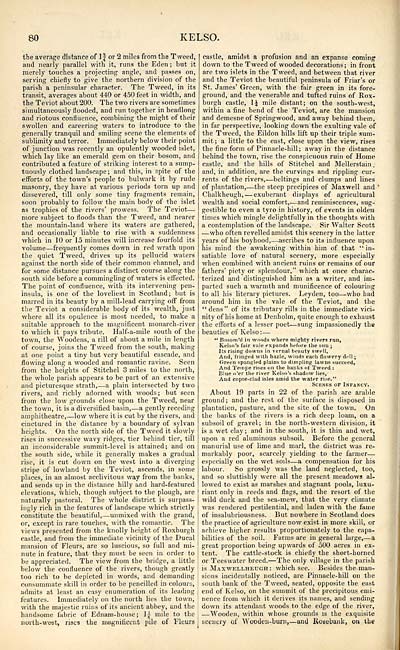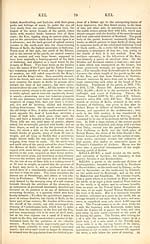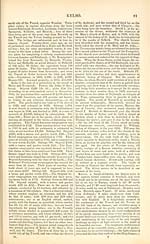Download files
Complete book:
Individual page:
Thumbnail gallery: Grid view | List view

80
KELSO.
the average distance of 1| or 2 miles from the Tweed,
and nearly parallel with it, runs the Eden ; but it
merely touches a projecting angle, and passes on,
serving chiefly to give the northern division of the
parish a peninsular character. The Tweed, in its
transit, averages about 440 or 4.50 feet in width, and
the Teviot about 200. The two rivers are sometimes
simultaneously flooded, and run together in headlong
and riotous confluence, combining the might of their
swollen and careering waters to introduce to the
generally tranquil and smiling scene the elements of
sublimity and terror. Immediately below their point
of junction was recently an opulently wooded islet,
which lay like an emerald gem on their bosom, and
contributed a feature of striking interest to a sump-
tuously clothed landscape ; and this, in spite of the
efforts of the town's people to bulwark it by rude
masonry, they have at various periods torn up and
dissevered, till only some tiny fragments remain,
soon probably to follow the main body of the islet
as trophies of the rivers' prowess. The Teviot —
more subject to floods than the Tweed, and nearer
the mountain-land where its waters are gathered,
and occasionally liable to rise with a suddenness
which in 10 or 15 minutes will increase fourfold its
volume — frequently comes down in red wrath upon
the quiet Tweed, drives up its pellucid waters
against the north side of their common channel, and
for some distance pursues a distinct course along the
south side before a commingling of waters is effected.
The point of confluence, with its intervening pen-
insula, is one of the loveliest in Scotland; but is
marred in its beauty by a mill-lead carrying off from
the Teviot a considerable body of its wealth, just
where all its opulence is most needed, to make a
suitable approach to the magnificent monarch-river
to which, it pays tribute. Half-a-mile south of the
town, the Woodens, a rill of about a mile in length
of course, joins the Tweed from the south, making
at one point a tiny but very beautiful cascade, and
flowing along a wooded and romantic ravine. Seen
from the heights of Stitchel 3 miles to the north,
the whole parish appears to be part of an extensive
and picturesque strath, — a plain intersected by two
rivers, and richly adorned with woods; but seen
from the low grounds close upon the Tweed, near
the town, it is a diversified basin, — a gently receding
amphitheatre, — low where it is cut by the rivers, and
cinctured in the distance by a boundary of sylvan
heights. On the north side of the Tweed it slowly
rises in successive wavy ridges, tier behind tier, till
an inconsiderable summit-level is attained; and on
the south side, while it generally makes a gradual
rise, it is cut down on the west into a diverging
stripe of lowland by the Teviot, ascends, in some
places, in an almost acclivitous way from the banks,
and sends up in the distance hilly and hard-featured
elevations, which, though subject to the plough, are
naturally pastoral. The whole district is surpass-
ingly rich in the features of landscape which strictly
constitute the beautiful, — unmixed with the grand,
or, except in rare touches, with the romantic. The
views presented from the knolly height of Roxburgh
castle, and from the immediate vicinity of the Ducal
mansion of Fleurs, are so luscious, so full and mi-
nute in feature, that they must be seen in order to
be appreciated. The view from the bridge, a little
below the confluence of the rivers, though greatly
too rich to be depicted in words, and demanding
consummate skill in order to be pencilled in colours,
admits at least an easy enumeration of its leading
features. Immediately on the north lies the town,
with the majestic ruins of its ancient abbey, and the
handsome fabric of Ednam-bouse; lj- mile to the
north-west, rises the magnificent pile of 1'leurs
castle, amidst a profusion and an expanse coming
down to the Tweed of wooded decorations; in front
are two islets in the Tweed, and between that river
and the Teviot the beautiful peninsula of Friar's or
St. James' Green, with the fair green in its fore-
ground, and the venerable and tufted ruins of Rox-
burgh castle, 1J mile distant; on the south-west,
within a fine bend of the Teviot, are the mansion
and demesne of Springwood, and away behind them,
in far perspective, looking down the exulting vale of
the Tweed, the Eildon hills lift up their triple sum-
mit ; a little to the east, close upon the view, rises
the fine form of Pinnacle-hill ; away in the distance
behind the town, rise the conspicuous ruin of Home
castle, and the hills of Stitchel and Mellerstain ,
and, in addition, are the eurvings and rippling cur-
rents of the rivers,— beltings and clumps and lines
of plantation, — the steep precipices of Maxwell and '
Chalkheugh, — exuberant displays of agricultural
wealth and social comfort, — and reminiscences, sug-
gestible to even a tyro in history, of events in olden
times which mingle delightfully in the thoughts with
a contemplation of the landscape. Sir Walter Scott
— who often revelled amidst this scenery in the latter
years of his boyhood, — ascribes to its influence upon
his mind the awakening within him of that " in-
satiable love of natural scenery, more especially
when combined with ancient ruins or remains of our
fathers' piety or splendour," which at once charac-
terized and distinguished him as a writer, and im-
parted such a warmth and munificence of colouring
to all his literary pictures. Leyden, too — who had
around him in the vale of the Teviot, and the
"dens" of its tributary rills in the immediate vici-
nity of his home at Denholm, quite enough to exhaust
the efforts of a lesser poet— sung impassionedly the
beauties of Kelso : —
" Bosom'd in woods where mighty rivers run,
Kelso's fair vale expands before the sun ;
Its rising downs in vernal beauty swell.
And, fringed with hazle, winds each flowery dell ;
Green spangled plaiDs to dimpling lawns succeed,
And Teuipe rises on the banks ot Tweed :
Blue o'er the river Kelso's shadow lies,
And copse-clad isles amid the water rise."
Scenes of Infancy.
About 19 parts in 22 of the parish are arable
ground ; and the rest of the surface is disposed in
plantation, pasture, and the site of the town. On
the banks of the rivers is a rich deep loam, on a
subsoil of gravel ; in the north-western division, it
is a wet clay ; and in the south, it is thin and wet,
upon a red aluminous subsoil. Before the general
manurial use of lime and marl, the district was re-
markably poor, scarcely yielding to the farmer — .
especially on the wet soils — a compensation for his
labour. So grossly was the land neglected, too,
and so sluttishly were all the present meadows al-
lowed to exist as marshes and stagnant pools, luxu-
riant only in reeds and flags, and the resort of the
wild duck and the sea-mew, that the very climate
was rendered pestilential, and laden with the fame
of insalubriousness. But nowhere in Scotland does
the practice of agriculture now exist in more skill, or
achieve higher results proportionately to the capa-
bilities of the soil. Farms are in general large, — a
great proportion being upwards of 500 acres in ex-
tent. The cattle-stock is chiefly the short-horned
or Teeswater breed. — The only village in the parish
is Maxwellheugh: which see. Besides the man-
sions incidentally noticed, are Pinnacle-hill on the
south bank of the Tweed, seated, opposite the east
end of Kelso, on the summit of the precipitous emi-
nence from which it derives its names, and sending
down its attendant woods to the edge of the river,
— Wooden, within whose grounds is the exquisite
scenery of Wooden-bum, — and Rosebank, on the
KELSO.
the average distance of 1| or 2 miles from the Tweed,
and nearly parallel with it, runs the Eden ; but it
merely touches a projecting angle, and passes on,
serving chiefly to give the northern division of the
parish a peninsular character. The Tweed, in its
transit, averages about 440 or 4.50 feet in width, and
the Teviot about 200. The two rivers are sometimes
simultaneously flooded, and run together in headlong
and riotous confluence, combining the might of their
swollen and careering waters to introduce to the
generally tranquil and smiling scene the elements of
sublimity and terror. Immediately below their point
of junction was recently an opulently wooded islet,
which lay like an emerald gem on their bosom, and
contributed a feature of striking interest to a sump-
tuously clothed landscape ; and this, in spite of the
efforts of the town's people to bulwark it by rude
masonry, they have at various periods torn up and
dissevered, till only some tiny fragments remain,
soon probably to follow the main body of the islet
as trophies of the rivers' prowess. The Teviot —
more subject to floods than the Tweed, and nearer
the mountain-land where its waters are gathered,
and occasionally liable to rise with a suddenness
which in 10 or 15 minutes will increase fourfold its
volume — frequently comes down in red wrath upon
the quiet Tweed, drives up its pellucid waters
against the north side of their common channel, and
for some distance pursues a distinct course along the
south side before a commingling of waters is effected.
The point of confluence, with its intervening pen-
insula, is one of the loveliest in Scotland; but is
marred in its beauty by a mill-lead carrying off from
the Teviot a considerable body of its wealth, just
where all its opulence is most needed, to make a
suitable approach to the magnificent monarch-river
to which, it pays tribute. Half-a-mile south of the
town, the Woodens, a rill of about a mile in length
of course, joins the Tweed from the south, making
at one point a tiny but very beautiful cascade, and
flowing along a wooded and romantic ravine. Seen
from the heights of Stitchel 3 miles to the north,
the whole parish appears to be part of an extensive
and picturesque strath, — a plain intersected by two
rivers, and richly adorned with woods; but seen
from the low grounds close upon the Tweed, near
the town, it is a diversified basin, — a gently receding
amphitheatre, — low where it is cut by the rivers, and
cinctured in the distance by a boundary of sylvan
heights. On the north side of the Tweed it slowly
rises in successive wavy ridges, tier behind tier, till
an inconsiderable summit-level is attained; and on
the south side, while it generally makes a gradual
rise, it is cut down on the west into a diverging
stripe of lowland by the Teviot, ascends, in some
places, in an almost acclivitous way from the banks,
and sends up in the distance hilly and hard-featured
elevations, which, though subject to the plough, are
naturally pastoral. The whole district is surpass-
ingly rich in the features of landscape which strictly
constitute the beautiful, — unmixed with the grand,
or, except in rare touches, with the romantic. The
views presented from the knolly height of Roxburgh
castle, and from the immediate vicinity of the Ducal
mansion of Fleurs, are so luscious, so full and mi-
nute in feature, that they must be seen in order to
be appreciated. The view from the bridge, a little
below the confluence of the rivers, though greatly
too rich to be depicted in words, and demanding
consummate skill in order to be pencilled in colours,
admits at least an easy enumeration of its leading
features. Immediately on the north lies the town,
with the majestic ruins of its ancient abbey, and the
handsome fabric of Ednam-bouse; lj- mile to the
north-west, rises the magnificent pile of 1'leurs
castle, amidst a profusion and an expanse coming
down to the Tweed of wooded decorations; in front
are two islets in the Tweed, and between that river
and the Teviot the beautiful peninsula of Friar's or
St. James' Green, with the fair green in its fore-
ground, and the venerable and tufted ruins of Rox-
burgh castle, 1J mile distant; on the south-west,
within a fine bend of the Teviot, are the mansion
and demesne of Springwood, and away behind them,
in far perspective, looking down the exulting vale of
the Tweed, the Eildon hills lift up their triple sum-
mit ; a little to the east, close upon the view, rises
the fine form of Pinnacle-hill ; away in the distance
behind the town, rise the conspicuous ruin of Home
castle, and the hills of Stitchel and Mellerstain ,
and, in addition, are the eurvings and rippling cur-
rents of the rivers,— beltings and clumps and lines
of plantation, — the steep precipices of Maxwell and '
Chalkheugh, — exuberant displays of agricultural
wealth and social comfort, — and reminiscences, sug-
gestible to even a tyro in history, of events in olden
times which mingle delightfully in the thoughts with
a contemplation of the landscape. Sir Walter Scott
— who often revelled amidst this scenery in the latter
years of his boyhood, — ascribes to its influence upon
his mind the awakening within him of that " in-
satiable love of natural scenery, more especially
when combined with ancient ruins or remains of our
fathers' piety or splendour," which at once charac-
terized and distinguished him as a writer, and im-
parted such a warmth and munificence of colouring
to all his literary pictures. Leyden, too — who had
around him in the vale of the Teviot, and the
"dens" of its tributary rills in the immediate vici-
nity of his home at Denholm, quite enough to exhaust
the efforts of a lesser poet— sung impassionedly the
beauties of Kelso : —
" Bosom'd in woods where mighty rivers run,
Kelso's fair vale expands before the sun ;
Its rising downs in vernal beauty swell.
And, fringed with hazle, winds each flowery dell ;
Green spangled plaiDs to dimpling lawns succeed,
And Teuipe rises on the banks ot Tweed :
Blue o'er the river Kelso's shadow lies,
And copse-clad isles amid the water rise."
Scenes of Infancy.
About 19 parts in 22 of the parish are arable
ground ; and the rest of the surface is disposed in
plantation, pasture, and the site of the town. On
the banks of the rivers is a rich deep loam, on a
subsoil of gravel ; in the north-western division, it
is a wet clay ; and in the south, it is thin and wet,
upon a red aluminous subsoil. Before the general
manurial use of lime and marl, the district was re-
markably poor, scarcely yielding to the farmer — .
especially on the wet soils — a compensation for his
labour. So grossly was the land neglected, too,
and so sluttishly were all the present meadows al-
lowed to exist as marshes and stagnant pools, luxu-
riant only in reeds and flags, and the resort of the
wild duck and the sea-mew, that the very climate
was rendered pestilential, and laden with the fame
of insalubriousness. But nowhere in Scotland does
the practice of agriculture now exist in more skill, or
achieve higher results proportionately to the capa-
bilities of the soil. Farms are in general large, — a
great proportion being upwards of 500 acres in ex-
tent. The cattle-stock is chiefly the short-horned
or Teeswater breed. — The only village in the parish
is Maxwellheugh: which see. Besides the man-
sions incidentally noticed, are Pinnacle-hill on the
south bank of the Tweed, seated, opposite the east
end of Kelso, on the summit of the precipitous emi-
nence from which it derives its names, and sending
down its attendant woods to the edge of the river,
— Wooden, within whose grounds is the exquisite
scenery of Wooden-bum, — and Rosebank, on the
Set display mode to: Large image | Transcription
Images and transcriptions on this page, including medium image downloads, may be used under the Creative Commons Attribution 4.0 International Licence unless otherwise stated. ![]()
| Gazetteers of Scotland, 1803-1901 > Topographical, statistical, and historical gazetteer of Scotland > Volume 2 > (92) Page 80 |
|---|
| Permanent URL | https://digital.nls.uk/97449694 |
|---|
| Description | Volume second: I-Z. |
|---|---|
| Shelfmark | Map Room Ref.2 |
| Attribution and copyright: |
|

